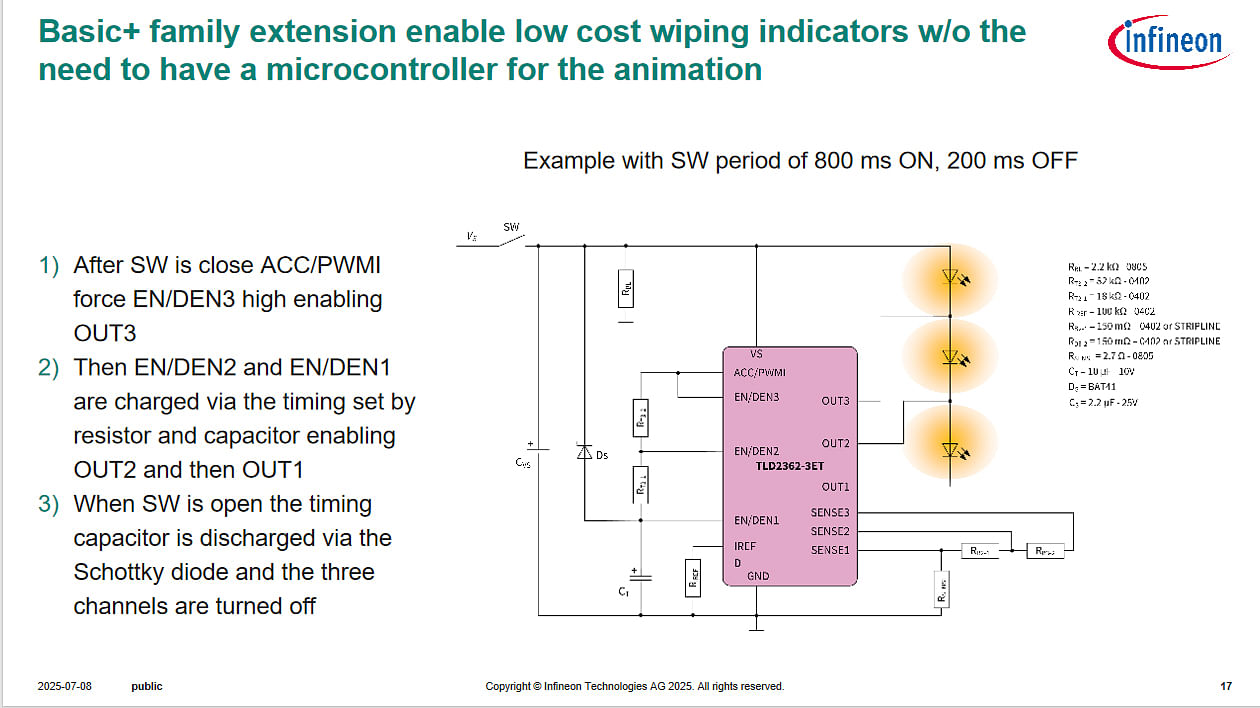Infineon targets demand for low-cost sequential-turn-indicator solutions
Infineon Technologies claims its LITIX range of low-power exterior and interior LED lighting semiconductor chips offer best-in-class current accuracy, EMC robustness, and thermal stability under varying ambient temperatures.
Lighting is emerging as a new style statement in modern vehicles, and globally, there is a clear demand for LED lighting solutions, be it for exterior or interior automotive lighting. One evident phenomenon which is picking up pace within this megatrend is that of sequential turn indicators, which are increasingly becoming commonplace and getting democratised from premium to even mass-market cars and two-wheelers.
Germany’s Infineon Technologies estimates that about 40% of the 1- to 3-channel rear lighting LED drivers require high currents – over 300mA – in the present day, and the demand for cost-effective, basic LED drivers from the Indian passenger vehicle market is set to register 5% CAGR by 2030-31. As a result, the company has showcased its latest range of LED drivers under its LITIX family of semiconductor chipsets that offer microcontroller-less operation for a cost-efficient application in sequential turn indicators.
According to Mark Jerome Turla Villamor, Senior Application Marketing Specialist, Infineon Technologies Asia Pacific, “LED technology today opens new horizons for lighting beyond illumination, and enables new value drivers across the entire value chain.” 
Turla was speaking at a webinar organised by Autocar Professional recently, wherein he also explained that LED technology opens new horizons for lighting beyond illumination and enables new value drivers such as ‘branding with lighting’ which is also emerging as a big trend in the future. According to the company, these features will drive the demand for BUS- and LIN-based LED lighting solutions.
Micro-controller-less operation
Infineon Technologies offers a wide range of LED drivers for the automotive segment with various exterior and interior lighting requirements, such as low-beam, high-beam, DRL, fog light, turn indicator, blind-spot light, and auto-dimming beam, among others – all catered with the right product. The company’s LITIX is its dedicated brand for LED exterior and interior lighting chips, and within the LITIX family, Infineon today offers the LITIX Linear, Basic and Basic+, with the latter being its latest product offering.
The company has expanded its LITIX Basic+ family with five new devices offering a power shift to drive higher currents – TLD2382 3ET- a 3-channel module with offload for up to 150mA; TLD2362 3ET – a 3-channel module with offload for up to 100mA, and TLD1173 1ET – a 1-channel module with offload for up to 400mA. According to Infineon Technologies, the LITIX Basic+ family offers the cheapest sweeping turn indicator solution that does not require power shift chips as well as a microcontroller.
The LITIX Basic+ module for animated lighting functions can provide output current of up to 100mA per channel; up to 150mA per channel with pre-regulator; and offer configurable fault management per device with a 1-fail-all-OFF, and a 1-fail-all-ON mechanism. It also offers analogue-digital dimming to adjust the output current, independent control of each output channel via EN/DENx, open load and short-to-battery detection, and thermal shutdown protection.

Sweeping function
Villamor considered an example of a sweeping indicator circuit with a switch ON period of 800ms, and a corresponding 200ms switch OFF. He explained that after the switch is closed, the Pulse-Width Modulation force enables OUT3, then EN/DEN2 and EN/DEN1 are charged through the timing set by the resistor and capacitor enabling OUT2 and OUT1. When the switch is open, the timing capacitor is discharged through the Shottky diode and the three channels are turned off.
The current through the LED chain rises up with the number of LEDs active, thus increasing the wiping effect. The chip resets at every ON-OFF cycle, so in case of a chip stuck, it is unlocked immediately.
According to Villamor, the resultant of this circuit is a sweeping indicator function, with key advantages such as – only one channel is working at the same time; low power is dissipated by the chip; only a few cheap components are needed, and there is no need for a microcontroller or power-shift featured chips either. The chips also offer best-in-class current accuracy of 4% in temperatures ranging from minus-4-degree Celsius to 150-degree Celsius, thermal derating via PTC/NTC resistor, as well as open-load, short-circuit over temperature protection.
Infineon Technologies envisions growing demand for its LED driver chipsets from the Indian automotive market, which is poised for robust growth in the future and is witnessing a sweeping premiumisation trend that is making customers seek more features that offer functionality as well as aesthetic appeal - albeit at a nominal cost. The company is geared to meet the market demand with its advanced product line-up.
ALSO READ:
Tata Elxsi and Infineon to develop EV systems for Indian market
RELATED ARTICLES
Forvia Appning and 4screen partner to transform the onboard experience
The partnership aims to enrich the driver and passenger experience by providing personalized and contextual recommendati...
ZF unveils next-gen intelligent chassis sensor
Upgraded version’s integrated accelerometer enables even more precise detection of relative motion in three dimensions a...
First BYD EV rolls off the line at new plant in Brazil
Chinese EV maker takes just 15 months from breaking ground to producing the Dolphin Mini, the first locally manufactured...





 23 Jul 2025
23 Jul 2025
 258 Views
258 Views





 Autocar Professional Bureau
Autocar Professional Bureau




